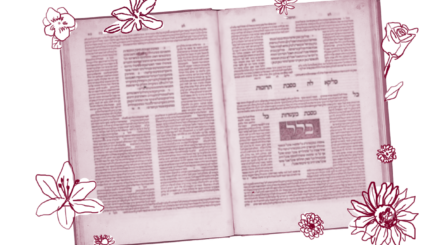On yesterday’s daf, the mishnah explored the question of whether it’s permissible to benefit from grapes that came into contact with wine used for idolatrous purposes. The mishnah ruled that if said grapes were whole, they can be rinsed and then used again. But if they were sliced or otherwise physically compromised, they are off limits. The mishnah identified the underlying principle this way: If wine used for idolatrous purposes enhances the flavor of whatever substance it touches, the substance is forbidden. But if the flavor of the touched substance does not change (at least not for the better), the substance remains permitted.
On today’s page, the rabbis express their dissatisfaction with this takeaway and debate the meaningfulness of this Jewish legal metric called noten ta’am (giving flavor).
Old wine (used for a libation that fell) onto grapes, all agree (they are forbidden) in a case where the wine imparts flavor. New wine (used for a libation that fell) onto grapes, Abaye says any amount is forbidden and Rava says only in a case where the wine imparts flavor.
According to everybody, old wine has a strong taste that changes the flavor of whatever it touches. But Abaye and Rava disagree about newer wine. Abaye argues that any amount of wine used for an idolatrous purpose can render items that it touches forbidden for Jewish usage, while Rava holds that freshly made wine only renders other foods forbidden if it changes their taste.
The Talmud tells us that Rava and Abaye argued nearly identical positions with regard to the permissibility of idolatrous vinegar that fell into a container of wine. Rava still worried exclusively about what this accidental recipe tasted like at the end of the day, while Abaye felt that a taste test was insufficient. He suspected that a mixture that smells like vinegar but tastes like wine must be evaluated by both senses. Abaye refused to abandon our olfactory senses in reaching these decisions, while Rava argued that inspecting with one’s nose was never enough to render something halakhically off limits.
The Talmud then recalls a debate over the permissibility of a Jew placing their nose to an inhalation hole punctured atop a barrel of wine owned by a gentile. Abaye forbade Jews from intentionally breathing in the odor from a liquid possibly assigned to an idolatrous purpose. But Rava insisted that a sniff is no matter of concern. Aside from the fact that the Torah never directly prohibits filling one’s nostrils with forbidden pleasures, a mishnah in Terumot explicitly permits the consumption of bread baked in an oven lined with cumin dedicated for Temple purposes because while the bread may have absorbed the aroma of the forbidden cumin, it didn’t absorb its flavor.
Nonetheless, this kind of permissive approach might have not seemed up to snuff for Abaye, who the Talmud tells us likely based his position on Deuteronomy 14:3: “Do not consume anything abhorrent.” For Abaye, the littlest drop, the faintest smell, and certainly the tiniest taste of something forbidden is sufficient to make the food forbidden.
Close readers of rabbinic texts may recall that when the sages seek the rationale for any mitzvah, they would ask the Aramaic question mai ta’ama, which literally means “What is the taste?” How a mitzvah tastes can only be known after taking a bite of Jewish living. Conversely, only somebody who has already deviated from the religious path will know how a transgression tastes. Abaye grew suspicious of taste alone as a tool for codifying law, figuring that if something smells disingenuous, discomfiting or otherwise inappropriate — morally, intellectually, religiously or otherwise — it should be forbidden. For Abaye, to smell halakhic concerns means committing to forethought — not merely to surrender to what is technically correct, but to trust all our senses and their capacity for holiness.
Read all of Avodah Zarah 66 on Sefaria.
This piece originally appeared in a My Jewish Learning Daf Yomi email newsletter sent on August 23, 2025. If you are interested in receiving the newsletter, sign up here.
With your help, My Jewish Learning can provide endless opportunities for learning, connection and discovery.



